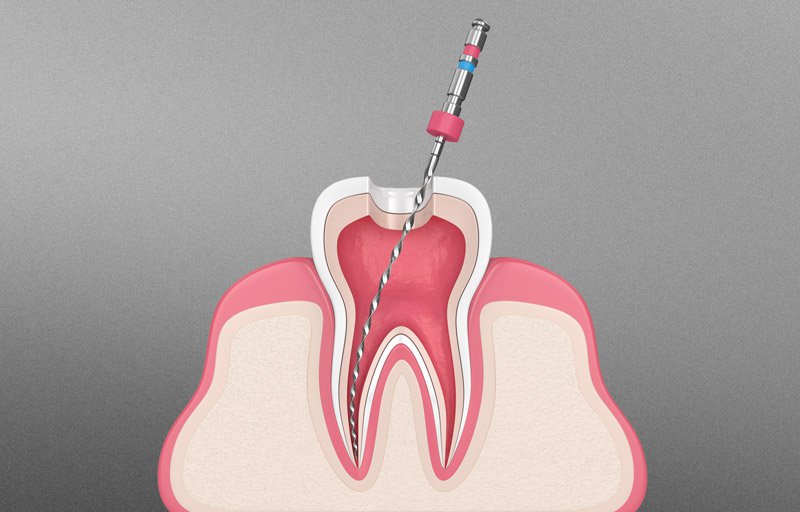Root Canal Therapy Miami
CG Smile performs root canal treatments in Miami. Call today for information on root canals and porcelain crown placements.
What to Expect?
When a dentist says that you will need a root canal treatment, your first thought will likely be that you're in for a painful procedure. But, in reality, root canal treatments are all about finding relief from pain and saving a tooth from disease.
At CG Smile, we perform root canal treatments for Miami patients that are looking to save a tooth ravaged by decay or one that has suffered dental trauma.


What's Involved with Root Canal Therapy?
Root canal therapy (or "root canal treatment") is often erroneously referred to as simply a "root canal." But, "root canal" is actually a term that refers to a specific part of a tooth's anatomy. The part of the tooth known as the root canal includes several parts of the tooth, including the pulp chamber, nerves, and blood vessels. When a root canal therapy is performed, these decayed tissues are removed and replaced with a dental filler. In most cases, a dental restoration is also recommended. (A root canal treatment without a restoration placed is known as a pulpectomy.)
Signs You May Need Root Canal Therapy?
Only through an evaluation with a dentist or endodontist will you know for sure whether root canal therapy is necessary. That being said, there are some signs you should look out for that may indicate an inner tooth infection (pulpitis).
Schedule a visit with your dentist if you notice:
- Significant pain when biting or chewing food
- Gums appear to be darker or have pimples
- Cracked or chipped tooth
- Tooth is more sensitive to hot and cold foods and drinks
- Gum tenderness or swelling
There are actually two forms of infections involving the pulp chamber of the tooth: reversible and irreversible pulpitis. In reversible pulpitis, the dentist can usually treat the tooth without the need for a full root canal treatment. With irreversible pulpitis, the only treatment that will bring the infection under control is root canal treatment.
The Root Canal Procedure
There are multiple steps to a root canal treatment. Depending on your treatment path, your own experience may vary compared to the descriptions listed below.
- Local anesthetic. Prior to any drilling, a local anesthetic is injected into nearby tissue. This will numb the nerves and you should experience some mild discomfort during the procedure.
- Dental dam. The dentist will prepare a dental dam around the tooth. This is done to keep the pulp chamber clean during the treatment.
- Drilling. This is the part that most patients fear: the drilling. But, in reality, the nerves of the tooth should have little feeling once the anesthesia takes effect. The dentist begins by drilling a small pilot hole to access the pulp chamber. This can be widened if needed.
- The infected tissue is removed. The dentist will use specialized tools to clean out the infected pulp tissue of the tooth. Using these tools, the dentist can actually reach down into the tooth root to remove any decayed tissue.
- Cleaning and preparing the inner chamber. To prepare the tooth for the filling, the dentist (or endodontist) will sterilize and sculpt the tooth canal.
- Filling the tooth. After the decayed tissue of the pulp has been removed and the chamber has been prepared, the dentist will fill the void using a thermoplastic known as gutta-percha, which is actually a type of latex harvested from a tree in Malaysia. Since gutta-percha is a simple hydrocarbon latex, it is biocompatible with the tissues of the tooth. Dental cement is then used to seal off the canal, protecting it from reinfection.
- The restoration. Most dentists and endodontists recommend that a crown be placed following root canal therapy. A crown gives the tooth some added strength while also serving as a protective barrier from bacteria. If you elect to have a crown placed, you will most likely leave your root canal treatment session with a temporary filling. On your follow-up appointment, a restoration will be completed on the tooth. This may involve a dental crown or some other kind of restoration.
What's the Recovery Process Like?
Since only a local anesthetic is used, a designated driver is not necessary. The first thing you will notice following the procedure is that there will be some lingering numbness. Therefore, you should wait to eat until all the feeling has returned to your tongue and mouth. This is to help protect against accidentally biting the tongue.
You may notice some inflammation around the tooth for the next few days. An over-the-counter NSAID such as Aspirin or Motrin® may be used to counter any residual pain or discomfort.
Avoid Hard, Chewy Foods
It's important to remember that until you have a restoration performed, the tooth will not be as strong as it once was. Therefore, try to chew only on the side of the mouth opposite of where your tooth canal was performed.
Have a Question About Root Canal Therapy?
Are you concerned about lingering tooth pain? Has it been a while since your last checkup? Call CG Smile in Miami for a consultation, today!
Root Canal FAQ
There are many factors that will influence the cost of a root canal treatment. Most dental insurance plans cover a large percentage of treatment costs, which will reduce your out-of-pocket expenses. Root canal treatments are seen as a less-expensive alternative to extracting a tooth and replacing it with a bridge or dental implant.
Yes and no. While you could extract the tooth and replace it with a bridge or implant, the one thing you shouldn’t do is ignore the situation altogether and hope that it heals on its own. When pulpitis goes untreated, it can turn into an abscess which can put your whole health and life at risk. Therefore, it’s best to trust the expertise of your doctor and follow through with the recommended course of treatment — it might just save your life!
To many patients, the words used to describe a pulpotomy, pulpectomy, and “root canal” all sound the same. But, in fact, there are some major differences that set these procedures apart from one another.
- Pulpotomy. When a pulpotomy is ordered, it means that the pulp of the crown will need to be removed due to infection, but the canal pulp is still healthy and will be left intact.
- Pulpectomy. You could say that all root canal treatments start with a pulpectomy, that is, the removal of all the pulp and nerves within the tooth. Pulpectomies are essentially root canal treatments that don’t progress to the restoration phase.
- Root canal therapy. The difference that sets root canal therapy apart from a pulpectomy is that root canal therapy also includes some type of dental restoration. This could be in the form of a permanent filling, crown, or some other type of dental restoration.